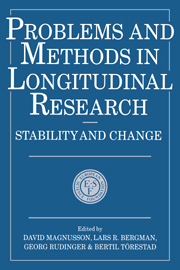Book contents
- Frontmatter
- Contents
- Contributors to this volume
- Foreword
- Preface
- 1 Studying individual development: problems and methods
- 2 Modeling individual and average human growth data from childhood to adulthood
- 3 Intraindividual variability in older adults' depression scores: some implications for developmental theory and longitudinal research
- 4 Now you see it, now you don't – some considerations on multiple regression
- 5 Differential development of health in a life-span perspective
- 6 Assessing change in a cohort-longitudinal study with hierarchical data
- 7 Statistical and conceptual models of ‘turning points’ in developmental processes
- 8 Qualitative analyses of individual differences in intra- individual change: examples from cognitive development
- 9 Application of correspondence analysis to a longitudinal study of cognitive development
- 10 Event-history models in social mobility research
- 11 Behavioral genetic concepts in longitudinal analyses
- 12 Genetic and environmental factors in a developmental perspective
- 13 Structural equation models for studying intellectual development
- 14 Longitudinal studies for discrete data based on latent structure models
- 15 Stability and change in patterns of extrinsic adjustment problems
- Index
11 - Behavioral genetic concepts in longitudinal analyses
Published online by Cambridge University Press: 27 April 2010
- Frontmatter
- Contents
- Contributors to this volume
- Foreword
- Preface
- 1 Studying individual development: problems and methods
- 2 Modeling individual and average human growth data from childhood to adulthood
- 3 Intraindividual variability in older adults' depression scores: some implications for developmental theory and longitudinal research
- 4 Now you see it, now you don't – some considerations on multiple regression
- 5 Differential development of health in a life-span perspective
- 6 Assessing change in a cohort-longitudinal study with hierarchical data
- 7 Statistical and conceptual models of ‘turning points’ in developmental processes
- 8 Qualitative analyses of individual differences in intra- individual change: examples from cognitive development
- 9 Application of correspondence analysis to a longitudinal study of cognitive development
- 10 Event-history models in social mobility research
- 11 Behavioral genetic concepts in longitudinal analyses
- 12 Genetic and environmental factors in a developmental perspective
- 13 Structural equation models for studying intellectual development
- 14 Longitudinal studies for discrete data based on latent structure models
- 15 Stability and change in patterns of extrinsic adjustment problems
- Index
Summary
The purpose of this chapter is to give a short description of some of the parameters of interest when behavioral genetic methods are applied to longitudinal designs. In order to make this clear, some examples will be provided from the ongoing Swedish Adoption/Twin Study of Aging (SATSA). Finally, several of the models currently being used will be presented and discussed.
PARAMETERS OF INTEREST OR WHAT DO WE WANT TO ASSESS?
To understand the application of behavioral genetic models to longitudinal designs, one must first be aware of the essential parameters in the simple univariate, one-occasion case. Unlike normative studies in which the primary emphasis is on mean levels of a behavior or phenotype, behavioral genetic studies focus on describing interindividual differences by partitioning phenotypic variance (P) into genetic (G) and environmental (E) sources of variation.
The relationship of these parameters can be described in an equation, the simplest of which is P = G + E, or in a path diagram (Figure 11.1). Regardless of form of presentation or number of parameters included, the main idea is to determine to what extent interindividual differences are due to genetic and environmental differences in the population. Behavioral genetic methodology applies the principles of quantitative genetics to the study of subjects with differing degrees of relatedness and varying similarities in their environments to partition variation. (For further descriptions of basic behavioral genetic techniques and their application to a variety of phenotypes, see Plomin, DeFries & McClearn, 1990.)
- Type
- Chapter
- Information
- Problems and Methods in Longitudinal ResearchStability and Change, pp. 236 - 249Publisher: Cambridge University PressPrint publication year: 1991
- 4
- Cited by



